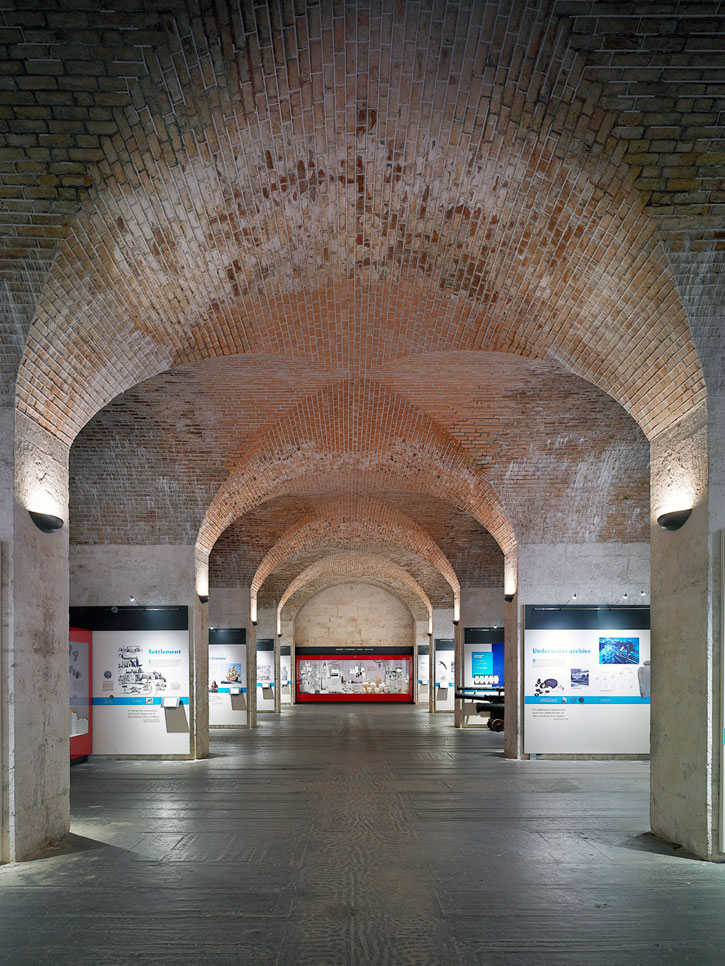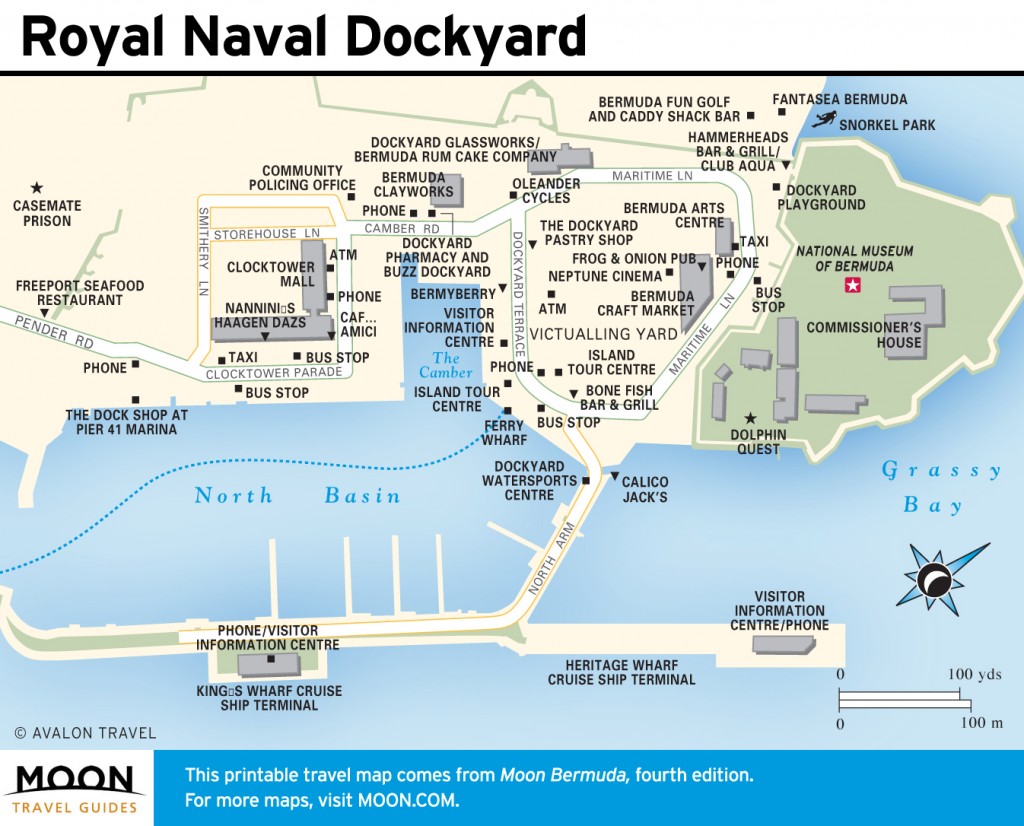
A National Museum of Bermuda exhibit showcases the legacy of shipwrecks. Photo © Rosemary Jones.
Until then, the museum remains headquartered in the Keep, a stronghold built within the fortified Dockyard to protect the entire Dockyard against attack by land or sea (though it never had to). The citadel has seven bastions and ramparts, reinforced by casemated gun emplacements with lines of sight sweeping the Great Sound and North and South Shores.
In the museum’s lower grounds, the cavernous Queen’s Exhibition Hall, where 4,860 kegs of gunpowder were once stored, has been updated with “Shipwreck Island,” a compelling showcase of early shipwrecks, including artifacts from the Sea Venture, Spanish gold, and rare 17th-century ship rigging. The exhibit also explores life aboard ships, and underwater archaeology. Across the lawn is the Boatloft, where traditional Bermuda fitted dinghies are on display, along with other island craft. The famous pilot gig Victory, fully rigged, and the century-old racing yacht Dainty are prize maritime treasures. There are also exhibits on fishing and turtling in this building, distinguished by its clock tower. Children like to climb on the regal statue of Neptune, Greek god of the sea, out in the Keep Yard.
Kids will also love the Museum Playground, opened in 2014 behind the QEH, where a 21-foot lighthouse and slide—ensnared by a 70-foot green moray eel—will inspire loads of pint-sized adventures. An interactive playhouse with exhibits on local history is planned for 2015.
Leading to the upper grounds from the ticket office is an intriguing exhibit created inside the atmospheric High Cave Magazine. “Prisoners in Paradise” details the story of Dockyard’s convict prisoners and Bermuda’s Boer War prisoners, groups who left their legacies in the form of beautiful carved woodwork and stone artifacts.
The crown jewel of the museum, however, is Commissioner’s House on the upper grounds, the grand home of the Dockyard’s civilian commissioner. It’s a building unlike any other in Bermuda, and one that—even if you’re not interested in its exhibits—offers a spectacular vantage point. From the top-floor wraparound veranda, the sweeping panorama of the entire Dockyard is revealed, as well as the glistening turquoise seascapes of both the North and South Shores. The world’s first cast-iron building, its girders, red brick, and flagstones were shipped from England in the 1820s, while its three-foot-thick walls consist of hard limestone quarried from the Dockyard. Restored in a mammoth 20-year campaign, the building reopened in 2000 as a museum. Three floors of exhibits fill Commissioner’s House, from rooms of rare Bermuda maps to those showcasing notes and coins, including historic Hogge money—the island’s first currency. Other rooms on the first floor are dedicated to exhibits detailing topics of cultural and social importance: the transatlantic slave trade and slavery in Bermuda; the Newport Bermuda Race; and the stories of Portuguese and West Indian immigrants. The second floor’s dining rooms pay tribute to the various military in Bermuda, with both the British Navy and U.S. Navy highlighted with photographs and artifacts. Take a look also at the stunning 36-seat dining table in the Commissioner’s Room, once a wartime mess hall, which now houses a collection of contemporary maritime art on loan from the Bank of Bermuda Foundation.

Royal Naval Dockyard
Downstairs on the ground floor, a dozen interlocking rooms contain the exhibit Bermuda’s Defence Heritage, detailing the story of local defense, from the forts and cannons of the 17th century to Bermudian vets of World War II. Military uniforms, medals, and munitions vividly depict the role tiny Bermuda played on the world stage. A documentary film here includes interviews with local veterans. There’s also the story of women at war: the island’s female military members who served overseas and the famous “censorettes”—young Englishwomen headquartered at the Hamilton Princess Hotel who were trained to sift through incoming mail and telecommunications, checking for coded messages being sent to Germany.
And don’t miss a towering mural in Pillared Hall (containing the rear interior staircase), where Bermudian artist Graham Foster spent three and a half years recreating Bermuda’s history in 1,000 square feet of floor-to-ceiling detail. The artwork was officially opened by the Queen in 2009. Accessible from the first floor or ground floor, the hall is located in the northwest corner of the museum, an artistic spectacle that has won rave reviews for Foster’s prodigious talent and spawned a 2011 coffee-table book.
A major player in the island’s heritage protection scene, the National Museum is also home to a conservation center, where artifacts found on local shipwrecks or terrestrial sites are preserved. The museum coordinates with historians, archaeologists, and teams from abroad to organize joint field trips and dives throughout the year. Books published by the museum press are sold in island bookstores.
Museum visitors can explore the historic windblown ramparts and gun placements around the Keep’s perimeter, where Bermuda’s only flock of sheep graze—natural lawnmowers for the property. Museum admission also allows you to view the dolphins of Dolphin Quest (15 Maritime Ln., tel. 441/234-4464, fax 441/234-4992, 9:30am-4:30pm), located at the Keep Pond on the lower grounds.
Excerpted from the Fourth Edition of Moon Bermuda.